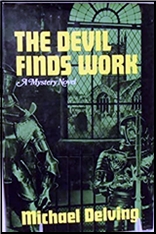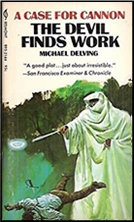Mon 27 Feb 2023
A 1001 Midnights Review: MICHAEL DELVING – The Devil Finds Work.
Posted by Steve under 1001 Midnights , Reviews[6] Comments
by Ellen Nehr & Bill Pronzini
MICHAEL DELVING – The Devil Finds Work. Dave Cannon #2. Scribner’s, hardcover, 1969. Belmont, paperback, 1971.

Of the six bibliomysteries Michael Delving (Jay Williams) wrote about the adventures, in England, of the two American partners of a Connecticut-based rare-book and manuscript firm, The Devil Finds Work is the only one featuring both Dave Cannon and Bob Eddison.
In the small town of Bartonbury, the two dealers are offered a collection of material belonging to Tristram Vail, a notorious Satanist who was once called “the wickedest man in the world.” They also find themselves caught up in the investigation of the theft of a silver cup from a desecrated church. When Vail’s secretary. Richard Foss, is found dead during another attempt to rob the church, Chief Inspector Codd — whom Delving introduced in the first Cannon/Eddison adventure, Smiling the Boy Fell Dead (1966) — is called in from Scotland Yard to investigate.
The odd activities of Vail’s ambiguous friend Anthony Gaunt play a role in the mystery. As does Bob (who is a full-blooded Cherokee from Oklahoma) being challenged by the local pub’s darts champion to a match in which Bob will use a bow and arrow and lined target, and the other player will use a regulation dart board with appropriate adjustments made for distance.

Another plot thread is Bob’s romantic interest in Jill Roseblade, the niece of an eccentric woman named Miss Trout, who owns a valuable Book of Hours coveted by the two partners. It is Codd, with help from Dave and Bob, who finally sorts out the disparate elements and solves the mystery.
Each of the characters in The Devil Finds Work is fully developed (Bob is especially well drawn), and the narrative is packed with vivid descriptions of village life, the English countryside and architecture, and various works of art. Delving was also a master at conveying the differences and similarities between the English and American ways of life. (Anthony Boucher said of him: “I can’t think of anyone since John Dickson Carr who has better handled England-from-an-American-viewpoint.”) And his knowledge of rare books and art is that of both an expert and connoisseur.
The other five books in the series are equally fine, in particular Die Like a Man (1970), in which Dave, traveling in Wales, is offered an ancient wooden bowl its owner claims is the Holy Grail; and A Shadow of Himself (1972), which is concerned with a seventeenth-century Dutch painting and in which Delving divulges the outcome of the romance between Bob and Jill. Because of such personal elements that carry over from book to book, a sequential reading of the series is recommended.
———
Reprinted with permission from 1001 Midnights, edited by Bill Pronzini & Marcia Muller and published by The Battered Silicon Dispatch Box, 2007. Copyright © 1986, 2007 by the Pronzini-Muller Family Trust.
February 28th, 2023 at 1:48 am
These seem like candidates for a new printing.
February 28th, 2023 at 11:47 am
None seem to be in print right now, as far as I’ve been able to learn, not even in eBook form. I enjoyed the one in the series I read, but which one, I no longer remember. It might have been this one!
February 28th, 2023 at 1:51 pm
A few are available on the internet archive: https://archive.org/search?query=creator%3A%22Delving%2C+Michael%2C+1914-%22
Apparently his real name is Jay Williams. https://en.wikipedia.org/wiki/Jay_Williams_(author)
February 28th, 2023 at 3:36 pm
Why do I insist on looking at only commercial sites (Amazon) and not the free ones (Internet archives)? Thanks, Tony!
March 1st, 2023 at 7:24 am
The young mystery/SF fan could do worse than look into Williams’s series about Danny Dunn. It’s no THREE INVESTIGATORS, but is still pretty enjoyable.
March 1st, 2023 at 9:20 pm
I quite liked Delving, I should look them up and try a reread. My memory of them is highly favorable.